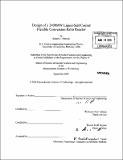| dc.contributor.advisor | Neil Todreas and Pavél Hejzlar. | en_US |
| dc.contributor.author | Petroski, Robert C | en_US |
| dc.contributor.other | Massachusetts Institute of Technology. Dept. of Nuclear Science and Engineering. | en_US |
| dc.date.accessioned | 2010-03-25T15:25:19Z | |
| dc.date.available | 2010-03-25T15:25:19Z | |
| dc.date.copyright | 2008 | en_US |
| dc.date.issued | 2008 | en_US |
| dc.identifier.uri | http://hdl.handle.net/1721.1/53281 | |
| dc.description | Thesis (S.M.)--Massachusetts Institute of Technology, Dept. of Nuclear Science and Engineering, 2008. | en_US |
| dc.description | Cataloged from PDF version of thesis. | en_US |
| dc.description | Includes bibliographical references (p. 143-145). | en_US |
| dc.description.abstract | A 2400MWth liquid-salt cooled flexible conversion ratio reactor was designed, utilizing the ternary chloride salt NaCl-KCl-MgCI2 (30%-20%-50%) as coolant. The reference design uses a wire-wrapped, hex lattice core, and is able to achieve a core power density of 130 kW/1 with a core pressure drop of 700kPa and a maximum cladding temperature under 650'C. Four kidney- shaped conventional tube-in-shell heat exchangers are used to connect the primary system to a 5450C supercritical CO2 power conversion system. The core, intermediate heat exchangers, and reactor coolant pumps fit in a vessel approximately 10 meters in diameter and less than 20 meters high. Lithium expansion modules (LEMs) were used to reconcile conflicting thermal hydraulic and reactor physics requirements in the liquid salt core. Use of LEMs allowed the design of a very favorable reactivity response which greatly benefits transient mitigation. A reactor vessel auxiliary cooling system (RVACS) and four redundant passive secondary auxiliary cooling systems (PSACS) are used to provide passive heat removal, and are able to successfully mitigate both an unprotected station blackout transient as well as protected transients in which a scram occurs. Additionally, it was determined that the power conversion system can be used to mitigate both a loss of flow accident and an unprotected transient overpower. | en_US |
| dc.description.statementofresponsibility | by Robert C. Petroski. | en_US |
| dc.format.extent | 145 p. | en_US |
| dc.language.iso | eng | en_US |
| dc.publisher | Massachusetts Institute of Technology | en_US |
| dc.rights | M.I.T. theses are protected by
copyright. They may be viewed from this source for any purpose, but
reproduction or distribution in any format is prohibited without written
permission. See provided URL for inquiries about permission. | en_US |
| dc.rights.uri | http://dspace.mit.edu/handle/1721.1/7582 | en_US |
| dc.subject | Nuclear Science and Engineering. | en_US |
| dc.title | Design of a 2400MW liquid-salt cooled flexible conversion ratio reactor | en_US |
| dc.type | Thesis | en_US |
| dc.description.degree | S.M. | en_US |
| dc.contributor.department | Massachusetts Institute of Technology. Department of Nuclear Science and Engineering | |
| dc.identifier.oclc | 547392330 | en_US |
